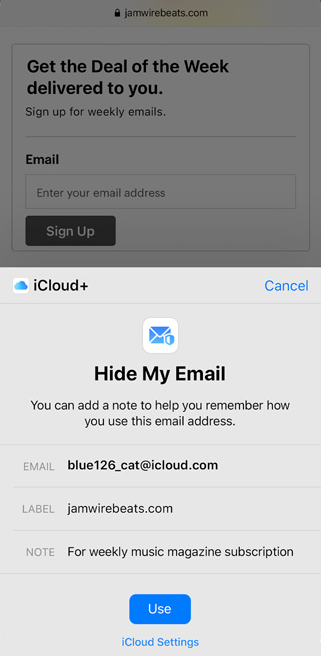In June 2021, Apple announced their iOS 15, iPadOS 15, macOS Monterey, and watchOS 8 with new privacy-protecting features. The official release took place in September. In this post, we will explore what effect Apple will have on email marketing.
Content:
Apple privacy updates
Privacy seems to have become one of the most disputed topics and is gradually obtaining new value. Following the latest trend in business and marketing, Apple has introduced a unique feature, Mail Privacy Protection. What’s all the fuss about?
To know when the email was opened and estimate a contact location, marketers need to add a small image to their message — an invisible tracking pixel. When users open an email with attached images, they download tracking pixels with them, which gets counted and reported as an open.
Now with privacy protection enabled, Apple Mail routes emails through a proxy server and pre-loads the content of an email even if the user hasn’t opened it yet. Therefore, if some of your customers use Apple devices with the new feature, you will not know when they actually open your emails — or if they do it at all.
With Apple privacy updates, users can obscure their IP addresses, which means that marketers will not be able to accurately determine the location of these contacts, along with their device type and email client. However, this policy only applies to emails opened in Apple Mail and does not affect other applications. The updates will not affect the deliverability of emails, and accurate click rates will still be reported.
Another Apple privacy update is the option to hide your actual email address. When filling out a form, users can put a randomly generated address that forwards to their personal inbox. Users can always provide a fake email instead of a personal one without any limits and then easily remove it, which means that companies can lose their connection to a client at the snap of a finger.

What impact can Apple have on email marketing metrics?
Apple will not just change email marketing, it might require you to reassess your measures of success. Here are some of the reasons why:
- analytics reports may show inaccurate or distorted number of opens, a lower “Clicks per unique open” rate, and unreliable data on geolocation and email clients;
- you may notice that the number of contacts in location-targeted segments has decreased due to their hidden IP addresses;
- if an Apple user who enabled privacy protection has not opened an email, they will not receive a resend;
- A/B test results based on open rates may have errors;
- the audience for triggered auto-flows will expand; consequently, if “not open” is the trigger, the number of contacts will decrease;
- even though you will not be able to monitor the open rates for Apple users, data on clicks and purchases will remain accessible, and these are the more significant engagement criteria anyway;
- your send optimization may be inaccurate if you don’t exclude the open rate from the algorithm; the same applies to any kind of content based on opens.
How to get more accurate metrics with Apple privacy updates
It seems that the changes iOS 15 has brought will inevitably affect email marketing and all future campaigns. What can we do about it? Closely following updates from Apple should definitely be on the list as there is still a lot to explore and analyze.
In the meantime, here is what you can do to adapt your business to succeed after Apple privacy updates:
Assess the potential impact of these innovations on your email campaigns before everyone has updated their devices to the latest version and turned on privacy protection. You need to check how many of your contacts use Apple Mail. The higher the percentage, the more likely you are to see an inflated open rate.
Change the way you measure the success of your email campaigns. With the launch of iOS 15, it’s best for your email marketing to concentrate on clicks while also monitoring the percentage of bounces, unsubscriptions, and conversions. If your account is connected to an online store, purchases should be considered a key metric as well.
You can use a double opt-in signup method. Although with a single opt-in, there are more chances for subscriptions because it requires less action from a user, a double opt-in is better for the deliverability of emails. A provider sees the addressee’s consent to receive emails, and so they do not go to their spam folder. Moreover, a double opt-in form allows you to assess the engagement of new subscribers.
Analyze your reach. Both contact rating and engagement depend on open rates, which can be deceptive. Consider cleaning up your contact list and creating an audience of non-Apple users to enhance your deliverability. Remember that although iOS 15 has a powerful impact on email marketing, it won’t affect all of your clients. You can still get reliable tracking data from other companies like Microsoft or Google if they don’t announce similar privacy updates. Moreover, Apple only caches images if the app is running, which means that these contacts receive your emails and are still valid.
Try to obtain location data directly from your contacts using surveys or forms. You can also use this strategy to gain customer feedback and learn about their interests, needs, and preferences.
Assess other parameters you can leverage if you were previously basing your audience segmentation on opens, contact rating, email client, location, or the level of engagement. Look for options that work best for you.
Update your automated emails. If an opening was the trigger, it might be worth changing it to clicks or purchases as more accurate engagement metrics. If you want to save the data about your existing journey, pause it and create a new one. If the trigger is “did not open,” consider changing it to “did not click.”
Think about updating your method to run A/B tests. Try implementing click rates if your A/B tests are based on open rates to yield more accurate results.
Consider sticking to clicks as they are a more reliable parameter that can provide you with accurate information. If you’re using opens to identify a contact’s email client, it’s a good idea to reconsider since this data might be misleading.
Wrapping it up
New privacy-protecting features for Apple devices are not making it easy for marketers. However, you can still use more reliable criteria like clicks and conversions to measure the effectiveness of email campaigns.
If you encounter some difficulties with email marketing, don’t sweat it too much. There are many other channels you can use to reach your clients, like chatbots for messengers, push notifications, SMS, and more. Together with email campaigns, all of this can be connected to the multichannel system with CRM. Use SendPulse tools to create successful marketing campaigns and track their performance.







